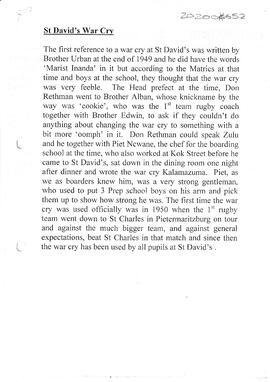Zona de identificação
Código de referência
Título
Data(s)
- 30 July 2009 (Produção)
Nível de descrição
Item
Dimensão e suporte
1 A4 printed page
Zona do contexto
Nome do produtor
História biográfica
Entidade detentora
História do arquivo
Historical Collection
Fonte imediata de aquisição ou transferência
Historical Collection
Zona do conteúdo e estrutura
Âmbito e conteúdo
From the desk of the Senior Deputy Headmaster
On Monday, 27 January, St David's Marist Inanda marks 73 years since the School officially opened
its gates: 73 years of history. In 1941, while WW 2 was raging across the globe, Marist Inanda was
established by the Marist Brothers on its current premises . The School in 1941 would have been
surrounded by grasslands, by veld, and located a fair distance from any significant urban
settlement – Rosebank would probably have been the nearest shops – a considerable walk on dirt
roads: certainly no tarred Rivonia Road. The area to the North and North East of the School, where
Sandton City is today, was predominantly fruit orchards and small holdings - how different the
environment in which the School now operates.
A little bit of History
The Marist blazer, the blue and gold striped blazer, was first introduced at St Charles College in
Pietermaritzburg, then a Marist School, in 1927. In 1933, all the Marist Schools in South Africa
adopted the blue and gold striped blazer as official uniform, no different to what St David's boys
wear today. Throughout the world, thousands of pupils wear the same blazer with passion and
pride - Marist is the common bond of pupils at hundreds of schools worldwide. The pocket of the
blazer has an 'A' and 'M' intertwined, standing for "Ave Maria", Latin for Hail Mary – this also
appears on the St David's badge.
The first reference to a war cry at St David's was written by Brother Urban at the end of 1949. The
first war cry included the words "Marist Inanda", but according to the Matrics of 1949, it was a
feeble war cry. The Head Prefect of 1949, Don Rethman, approached the first team rugby coaches,
Brother Alban and Brother Edwin, and asked permission for changing the war cry to something
with a bit more "oomph", something more lively and dynamic. Permission was granted and the
Head Prefect, who could speak Zulu, together with the School's Chef, Piet Ncwane, who had moved
to St David's from Marist Koch Street (the first school in Johannesburg), sat down in the dining
room one night after dinner and wrote the War Cry – the Kalamazumba: the one St David's boys still
sing/chant. By the way, our current library is the old dining room and besides his cooking and
song-writing skills, the School Chef, Mr Ncwane, who co-wrote the war cry, was by all accounts an
immensely powerful gentleman, who was reputed to be able to pick up three prep boys sitting on
his one arm!
The Kalamazumba was officially used for the first time in 1950 when the 1st XV played against St
Charles College in Pietermaritzburg. St David's, the underdogs on that day, against expectations,
beat St Charles. Much credit for the victory was given to the new war cry and, since that historic
match in 1950, the Kalamazumba has been used at all fixtures by the boys of St David's Marist
Inanda.
Avaliação, selecção e eliminação
Ingressos adicionais
Sistema de arranjo
A27 with a printed copy and content in this entry
Zona de condições de acesso e utilização
Condições de acesso
Copyright St David's Marist Inanda
Condiçoes de reprodução
Copyright St David's Marist Inanda
Idioma do material
Script do material
Notas ao idioma e script
Características físicas e requisitos técnicos
Instrumentos de descrição
Zona de documentação associada
Existência e localização de originais
Existência e localização de cópias
Unidades de descrição relacionadas
Zona das notas
Identificador(es) alternativo(s)
Pontos de acesso
Pontos de acesso - Assuntos
Pontos de acesso - Locais
Pontos de acesso - Nomes
- Castle, W J (Assunto)
- Brother Edwin (Assunto)
- Ncwane, Piet (Assunto)
- Rethman, D (Assunto)


